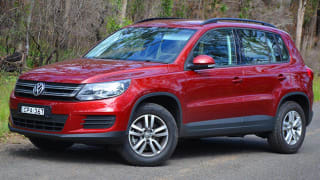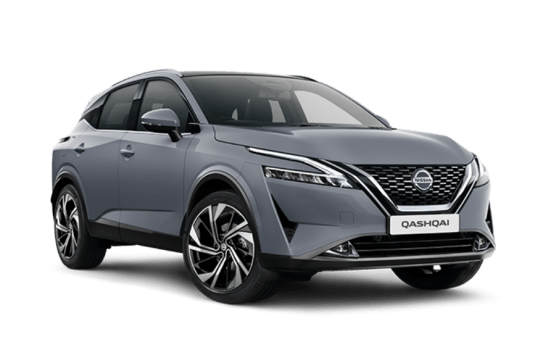
Volkswagen Tiguan 2014 Review
Malcolm Flynn road tests and reviews the Volkswagen Tiguan 118TSI, with specs, fuel consumption and verdict.
Browse over 9,000 car reviews
When carmakers opt for a model name change, it’s generally a sign that the previous generation is in need of a personality injection to address flagging sales.
However, Nissan’s shift to the Qashqai nameplate for the second-generation of its small SUV comes after the Dualis predecessor was narrowly pushed back to a third-place sales ranking over its final six months on sale.
Behind the Hyundai ix35 and Subaru XV to the end of June, the Dualis sat ahead of strong rivals like the Mitsubishi ASX and Volkswagen Tiguan in a highly competitive segment – so the Dualis name was strong.

While the second-generation Tiguan is imminent, properly new ix35 and ASX models are some way off, giving the completely redesigned Qashqai a significant leg-up in the market.
And this small SUV market is growing too, as more buyers wake up to the benefits of models no larger or less manoeuvrable than the top-selling Toyota Corolla and Mazda3, but offer more practical cabins with better access and are less likely to destroy their bumpers over carpark dividers.
So why the name-change now after the original model was known as Qashqai in Europe since 2007? Nissan is keen to strengthen the nameplate’s recognition on a global scale, and the Japanese brand’s Australian arm believes this new model has the substance to pull off such a move without alienating local fans of the original.
Slightly longer and wider but lower than the five-seat Dualis it replaces, the Qashqai is arguably the best execution of Nissan’s new design language to date. The Qashqai’s proportions significantly trump the larger X-Trail and Pathfinder that introduced the theme, and approach the likes of the Mercedes GLA for aesthetic balance.
Gone is the elongated seven-seat version along with all-wheel drive in any form, with Nissan confident the larger X-Trail will satisfy both requirements - along with less efficient all-wheel drive models representing a shrinking five per cent of Dualis sales.
The Qashqai rides on a scaled-down version of the X-Trail’s Renault/Nissan Alliance’s scalable Common Module Family (CMF) architecture, with a 59mm shorter 2646mm wheelbase. Suspension is by MacPherson struts up front and a multilink setup at the rear.
The interior also continues with the theme introduced by the X-Trail, with fresh and appealing shapes and quality-feel materials.
No ergonomic concerns were raised during our test, and the back seat has plenty of room for two adults, with easy access and a high seating position promises a reasonable view for children.
Child seat anchorage points are ISOFIX in the outward positions and top tether across all three rear seats.
Cargo space in the rear has grown by 20-litres to 430, and features a 16 position flexible floor layout on top of a spacesaver spare.
Like the Dualis, petrol Qashqai variants continue to be available in two trim levels with a choice of six-speed manual or Xtronic CVT auto, kicking off with the manual Qashqai ST at a $140 cheaper $25,850, and topping off with the $34,990 auto Ti that represents a $100 saving over the equivalent Dualis Ti-L.
Unlike the Dualis diesel’s single TS-spec, the turbodiesel Qashqai is now be available across two equipment grades, with the $33,200 TS and $37,990 TL range-topper. Both shift from the Dualis diesel’s manual-only status to being paired with the CVT auto as the sole choice.
The base ST grade comes equipped with a leather steering wheel and gearknob, 5-inch multimedia screen with the NissanConnect smartphone interface (with Facebook, Pandora and Google embedded apps), standard reversing camera, LED daytime running lights and 17-inch alloys.
The diesel TS adds premium cloth trim, dual-zone climate control, keyless start, power folding mirrors, foglights, auto wipers, tinted windows, driver’s lumbar adjustment, rear armrest and six-speaker audio. Rear parking sensors are available as an option on ST and TS models for $449 fitted.
The Ti petrol and TL diesel models score leather trim with front seat heaters, a 7-inch multimedia screen with satnav, Around View multi-camera display, front and rear parking sensors, a panoramic glass roof, LED headlights with auto high/low beams, an auto-parking function plus blind-spot, lane departure, moving object and driver attention alerts and 19-inch alloys.
The Qashqai is also the first model to benefit from Nissan's revised 12month/10,000km (from 6month/10,000km) capped-price servicing shedule, which will result in significant savings for those who travel up to 10,000km each year. Other Nissan models will follow suit shortly.
The Qashqai continues with the Dualis’s 2.0-litre petrol and 1.6-litre diesel drivetrain options, with the MR20 petrol unit also used in the X-Trail massaged with direct injection to produce another 4kW/2Nm to total 106kW and 200Nm.
The strong R9M turbodiesel retains its previous 96kW/320Nm outputs and efficiency-boosting stop/start system.
Both engines use the same Xtronic CVT unit as seen in the X-Trail for automatic duties, which has helped combined fuel consumption drop by 1.3L/100km to 6.9 for petrol models, but the diesel consumes 0.4L/100km more at 4.9 with the auto now attached.
Like many new models, the price-leading six-speed manual petrol ST stretches fuel consumption out to 7.7L/100km, which is 0.4L/100km better than the equivalent Dualis.
Braked tow ratings are also carried over from the Dualis, with auto petrol models capable of towing 1200kg, and manual petrol and all diesel variants rated at 1400kg.
The Qashqai carries over the maximum five star ANCAP rating of the Dualis, with dual frontal, side and full-length curtain airbags as standard. The Qashqai stability control system encompasses ABS and EBD, with torque-vectoring Active Trace Control that apportions power to individual driven wheels for the benefit of stability.
ANCAP has highlighted the lack of Advanced Emergency Braking (AEB) available for Australian and New Zealand-spec models, while the feature is available in the Qashqai’s native Europe. The Qashqai’s crash performance earned it the maximum rating nonetheless.
The Qashqai feels much like a downsized X-Trail on the road, but better. The shorter and lower body is more nimble, and the body control has a European feel to its dampening.
Like the Dualis, the Qashqai is sourced from the UK and designed primarily for Europe, which helps explain the dynamically-focused but more expensive multilink rear end.
Unsurprisingly, the ride is better on the ST and TS variants’ taller-tyred 17-inch wheels. The better looking 19s on the Ti and TL make for a sharper experience over bumps and road markers, but remain well damped and stable at the limit.
The electric steering won’t rival a Porsche for feel, but it’s hardly the worst system around, and offers the choice between Normal and Sport assistance modes. Like most similar arrangements, we found Sport unnecessarily stiff, but there’s no harm in having the option.
Like most stylish SUVs these days, rearward visibility isn’t the best due to thick C-pillars and small rear window, but any reversing guesswork is eliminated by the standard cameras on all grades.
We sampled both engines in auto guise at the Qashqai’s Australian launch, and the petrol with the CVT works just as well as the same combination in the X-trail. The Xtronic unit may still buzz more than a torque converter auto, but is better than most and the 2.0-litre is more spritely in the lighter Qashqai.
The pairing of the turbodiesel with the CVT was a revelation however, with the 1.6’s maximum torque delivery from 1750rpm eliminating the need for the very revs that incite the oft-criticised CVT buzz. The engine itself is quieter and smoother than you’d expect also. At a steady cruise, you’d be hard pressed to pick it from the petrol by ear.
Despite producing a muscular 320Nm from just 1.6-litres, there’s also little turbo lag from the diesel engine. It’s easily the punchier of the two underfoot, but the 2.0-litre petrol has plenty of go to keep you out trouble.
The Nissan Qashqai represents a fresh burst in a competitive but otherwise ageing segment. It delivers all the wishlist items asked of a modern small SUV and will make a handy daily accomplice for many.
The Qashqai’s compact dimensions help make it a better drive than most mid-size SUVs, so do consider whether you need their extra space before signing on the dotted line.
| Vehicle | Specs | Price* | |
|---|---|---|---|
| ST (4X2) | 2.0L, ULP, 6 SP MAN | $13,090 – 17,490 | 2014 Nissan Qashqai 2014 ST (4X2) Pricing and Specs |
| TS | 1.6L, Diesel, CVT AUTO | $16,170 – 20,680 | 2014 Nissan Qashqai 2014 TS Pricing and Specs |
| Ti (4x2) | 2.0L, ULP, 6 SP MAN | $14,850 – 19,580 | 2014 Nissan Qashqai 2014 Ti (4x2) Pricing and Specs |
| TL | 1.6L, Diesel, CVT AUTO | $16,610 – 21,340 | 2014 Nissan Qashqai 2014 TL Pricing and Specs |
$11,990
Lowest price, based on 85 car listings in the last 6 months